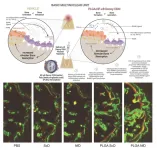(Press-News.org) Your circadian rhythm doesn’t just govern your sleeping schedule; it can also impact cancer development, diagnosis, and treatment. In a review paper publishing in the journal Trends in Cell Biology on March 24, researchers discuss the role of circadian rhythms in tumor progression and spread and describe how we could better time when patients are tested for cancer and when they receive therapies to improve diagnostic accuracy and improve treatment success.
“The circadian rhythm governs most of the cellular functions implicated in cancer progression, and therefore its exploitation opens new promising directions in the fight against metastasis,” write the authors, molecular oncologists Zoi Diamantopoulou, Ana Gvozdenovic, and Nicola Aceto from the ETH Zurich in Switzerland.
Our circadian rhythms help our bodies synchronize different tasks throughout the day, including gene expression, immune function, and cell repair. We’ve long known that chronically disrupted circadian rhythms—as a result of erratic sleep patterns, jet lag, or shift work, for example—can predispose us to a number of health issues, including cancer. More recent work has shown that circadian rhythms are not only involved in tumor onset, but also govern cancer progression and metastasis, the colonization of secondary sites within the body.
Metastasis is the main cause of death in cancer patients. For metastasis to occur, cells need to break away from the primary tumor, enter the bloodstream, and then travel to and infiltrate a new organ. Studies have shown that the rate at which cancer cells break away from the primary tumor and enter into the bloodstream oscillates rhythmically throughout the day, but the timing of this rhythm differs between cancer types. For example, breast cancer is more likely to metastasize at nighttime, while we’re asleep, whereas prostate cancer and multiple myeloma peak at other points during the day.
The authors argue that we could leverage this information when administering chemo- and immunotherapies to target tumor cells at the optimal time. The practice of delivering medication and immune therapies at specific times of day is known as chronotherapy.
“Circadian rhythm-based metastasis formation should be seen as an opportunity to intervene in the most timely and effective way,” the authors write. “Chronotherapy holds promise to be a valuable alternative treatment option in the fight against cancer.”
Clinical studies have shown that chronotherapy can reduce the severity of side effects experienced by patients and can also impact treatment effectiveness. For example, the authors describe a recent study in which melanoma patients who received immunotherapeutic drugs before 4:30 pm were nearly twice as likely to survive as patients who received the treatment later in the day. The optimal timing varies for different cancer types and therapeutics, and the authors also note that the clinical benefits of chronotherapy might be affected by factors such as the patient’s sex and genetic background.
Knowledge of the circadian rhythms of cancer cells could also aid cancer diagnosis. Cancer cells produce proteins at different rates throughout the day, and some of these proteins are used as diagnostic molecular markers. We could decrease the chances of misdiagnosing a patient by collecting and testing biopsies at the time of the day when the concentration of these proteins is highest.
“More mechanistic understanding of these processes will be required to fully unleash its potential on the clinical side,” the authors write. “Defining the circadian-rhythm-controlled timing of proliferation and release of circulating tumor cells into the bloodstream in additional cancer types may help to identify the optimal time window for therapy administration.”
###
This research was supported by the European Research Council, the European Commission, the Swiss National Science Foundation, the Swiss Cancer League, and ETH Zürich.
Trends in Cell Biology, Diamantopoulou et al. ‘A new time dimension in the fight against metastasis’ https://www.cell.com/trends/cell-biology/fulltext/S0962-8924(23)00021-1
Trends in Cell Biology (@TrendsCellBio), published by Cell Press, is a monthly review journal of molecular and cell biology. Monitoring the breadth and depth of current research in cell biology, articles report on new developments as they happen and integrate methods, disciplines, and principles. Visit: http://www.cell.com/trends/cell-biology. To receive Cell Press media alerts, please contact press@cell.com.
END
Newly developed mRNA vaccines against Zika virus and HIV-1 produced strong antibody responses that transferred from pregnant rabbits to their offspring, researchers report March 24th in the journal Molecular Therapy. As noted by the authors, the results support further development of their vaccine platform, LIONTM/repRNA, for maternal and neonatal settings to protect against mother-to-child transmission of pathogens in animals and humans.
The recent success of mRNA vaccines in response to the COVID-19 pandemic is a catalyst for the development of mRNA vaccines targeting other infectious diseases. The U.S. Food and Drug Administration has authorized mRNA vaccines for children ...
A novel statewide incentive program intended to improve “warm hand-offs” from Pennsylvania emergency departments to opioid use disorder treatment programs is associated with a 50% improvement in the initiation of medication-assisted treatment in Medicaid-enrolled patients, according to new research from University of Pittsburgh, Howard University, Johns Hopkins University, University of Pennsylvania and Vital Strategies scientists. The finding, published today in JAMA Health Forum, points to a potential policy ...
About The Study: Marriage and children were associated with a greater earnings penalty for female physicians, primarily due to fewer hours worked relative to men, in this study of 95,000 U.S. physicians. Addressing the barriers that lead to women working fewer hours could contribute to a reduction in the male-female earnings gap while helping to expand the effective physician workforce.
Authors: Lucy Skinner, M.P.H., of the Geisel School of Medicine at Dartmouth in Hanover, New Hampshire, is the corresponding author.
To access the embargoed study: Visit ...
About The Study: In this study using data from 3,037 community-dwelling Medicare beneficiaries, food insecurity was prevalent and associated with a decline in executive function. Interventions and policies aiming to increase healthy food access or reduce food insecurity should be assessed for their impact on older adults’ cognitive outcome.
Authors: Boeun Kim, Ph.D., M.P.H., R.N., of Johns Hopkins University in Baltimore, is the corresponding author.
To access the embargoed study: Visit our For The Media website at this link https://media.jamanetwork.com/
(doi:10.1001/jamanetworkopen.2023.4674)
Editor’s ...
Lower electricity costs for consumers and more reliable clean energy could be some of the benefits of a new study by the University of Adelaide researchers who have examined how predictable solar or wind energy generation is and the impact of it on profits in the electricity market.
PhD candidate Sahand Karimi-Arpanahi and Dr Ali Pourmousavi Kani, Senior Lecturer from the University’s School of Electrical and Mechanical Engineering, have looked at different ways of achieving more predictable renewable energy with the ...
Higher alcohols (C2+ alcohols), which are important raw materials, have been used as the intermediates of valued products. They are also widely applied in various fields of fuel, food, fine chemicals, pharmaceuticals and energy.
With the gradual depletion of petroleum resources, the direct synthesis of higher alcohols from syngas has become a sustainable and potential process because of its wide source of raw materials and high atomic utilization. However, the low yield of higher alcohols restricted industrial application.
Recently, a research team led by Prof. SUN Jian and Prof. GE Qingjie from the Dalian Institute of Chemical Physics (DICP) of the Chinese Academy of Sciences (CAS) has ...
Researchers from Tokyo Medical and Dental University (TMDU) demonstrate how a polymeric nanoparticle gene delivery system can promote bone formation
Tokyo, Japan - Does a “magic bullet” exist in regenerative medicine? Researchers have long wished to design a cutting-edge gene therapy that regenerates tissues damaged by disease or trauma. That wish may come true now that a research team has developed a polymeric gene delivery therapy that promotes new bone formation after traumatic inflammation.
In a study published this month in the International Journal of Molecular Sciences, researchers from ...
Pesticide use must be reduced. The EU has set a target to reduce pesticide use by 50% by 2030. Therefore, a strong focus on integrated weed management must be maintained in the coming years. When it comes to weeds, the focus has mainly been on improving the efficacy of pesticides, replacing or complementing them with mechanical treatments in the field.
In the last five years, the Horizon 2020 project IWMPraise – Integrated Weed Management: PRActical Implementation and Solutions for Europe has conducted a large number of trials on ...
LMU chemists use high-precision quantum chemistry to study key elements of super-efficient energy transfer in an important element of photosynthesis.
Photosynthesis is the motor of all life on Earth. Complex processes are required for the sunlight-powered conversion of carbon dioxide and water to energy-rich sugar and oxygen. These processes are driven by two protein complexes, photosystems I and II. In photosystem I, sunlight is used with an efficiency of almost 100%. Here a complex network of 288 chlorophylls plays the decisive role. A team led by LMU chemist Regina de Vivie-Riedle has ...
Blind people are better at sensing their own heartbeats than sighted, shows a study by researchers at Karolinska Institutet in Sweden and Jagiellonian University in Poland. The study indicates that blindness leads to a heightened ability in feeling signals from the inner body. The findings are published in the Journal of Experimental Psychology: General.
Thirty-six blind and as many sighted individuals were asked to count their own heartbeats without checking their pulse or touching their body. At the same time, the ...

